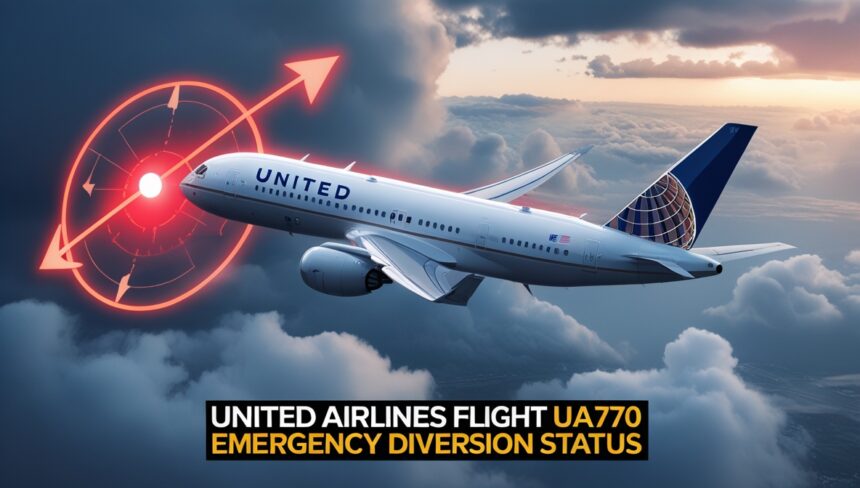Air travel today is considered one of the safest modes of transportation. However, unexpected events still occur, reminding us of the importance of strict safety measures and well-prepared crews. Recently, United Airlines Flight UA770 — traveling from Barcelona to Chicago — experienced an in-flight emergency and was diverted to London Heathrow. While every passenger landed safely, the incident highlighted the efficiency of safety systems in aviation.
This analysis explores what happened, why it matters, and the lessons passengers and airlines can take from the UA770 diversion.
What Happened on Flight UA770
United Airlines Flight UA770 was on its transatlantic route when the crew identified a potential issue requiring immediate attention. Following standard procedure, the pilots declared an emergency and coordinated with air traffic control to divert to the nearest suitable airport. London Heathrow, one of the world’s busiest and best-equipped airports, was chosen.
Emergency crews were on standby, and the landing was carried out safely. Once on the ground, passengers were guided off the aircraft, provided with assistance, and supported with onward travel arrangements.
Why Diversions Are Necessary
Prioritizing Passenger Safety
The decision to divert a flight is never taken lightly. It comes with major logistical and financial challenges for the airline. However, safety always comes before convenience. By choosing to land at Heathrow, the crew ensured passengers and crew members had access to the best emergency and support services available.
Rapid Decision-Making
Pilots must weigh factors such as fuel, distance to the nearest airport, and available facilities when declaring an emergency. UA770 showed how quick decision-making prevents small issues from becoming larger problems.
How the Crew Responded
Pilots at the Core of Safety
Pilots undergo extensive training to handle emergencies. From engine warnings to medical issues onboard, they rehearse countless scenarios in simulators. On UA770, their actions reflected this training — quick communication, decisive judgment, and coordination with air traffic control.
Cabin Crew’s Vital Role
While the pilots handled technical operations, the cabin crew reassured passengers, maintained order, and prepared everyone for the diversion. For travelers, their calm and clear communication helped reduce fear and confusion.
Read Also: Why Expo 2028 Phuket is the Must-Visit Event for Future Travelers
Communication: The Key to Passenger Confidence
During emergencies, information is everything. Passengers don’t expect technical breakdowns of the issue; they simply want to know if they’re safe and what to expect next.
- Announcements in-flight kept travelers updated.
- Guidance on the ground ensured everyone knew what to do after landing.
- Airline coordination helped passengers rebook connections or arrange accommodations.
Clear communication is often the difference between panic and calm in unexpected situations.
Technology’s Role in Managing Emergencies
Today, flights are tracked in real time, allowing airlines, regulators, and even the public to monitor aircraft status. UA770’s diversion was visible through tracking platforms, reassuring families waiting at the destination that the aircraft had landed safely.
For airlines, technology also ensures rapid response: maintenance crews can prepare for inspections, and ground staff can be positioned to meet passengers upon arrival. This level of transparency has become an essential part of modern aviation.
Lessons for Passengers
Always Keep Essentials in Your Carry-On
Unexpected diversions may mean long waits at airports or overnight stays. Travelers should keep medicines, chargers, travel documents, and a change of clothes in their hand luggage.
Stay Calm and Listen to Instructions
Crew members are highly trained for these events. Following directions without panic allows them to focus on ensuring everyone’s safety.
Be Ready for Delays
Missed connections and schedule changes are common after diversions. Travel insurance, airline apps, and flexible planning can ease the stress when plans change.
Lessons for Airlines and Airports
Coordinated Response Matters
UA770 demonstrated the importance of seamless coordination between pilots, crew, air traffic control, ground staff, and emergency responders. Each played a vital role in the safe conclusion of the incident.
Transparency Builds Trust
Quick, honest updates from airlines prevent rumors and maintain public trust. Even when full details are not immediately available, acknowledging the event and reassuring passengers is crucial.
Continuous Training Pays Off
From cockpit crew to airport emergency teams, rigorous training ensured everyone knew their role. That preparation directly translated into passenger safety.
Investigations and Follow-Ups
Every diversion prompts a full inspection and investigation. Maintenance teams check the aircraft thoroughly, and reports are compiled to understand the cause. Whether the incident involved a technical issue, system alert, or precautionary measure, these reviews are essential to preventing future risks.
Passengers may not always hear the full technical outcome, but they can be assured that these processes are thorough and mandatory in aviation.
The Bigger Picture: Aviation Safety as a System
Aviation safety does not depend on a single decision or individual. It’s a system made up of multiple layers: pilot training, aircraft engineering, airport readiness, regulatory oversight, and passenger cooperation.
The UA770 diversion is a reminder that when all these layers work together, even unexpected events end safely. Every emergency becomes a real-world test of the aviation safety net, and in this case, it proved its strength.
Final Thoughts
The safe diversion of United Airlines Flight UA770 is proof that safety in aviation is not just a promise — it is a system that functions under pressure. Pilots made the right decision, crews executed their roles, emergency teams responded effectively, and passengers were brought safely to the ground.
For travelers, the lessons are simple: trust the system, stay prepared, and remain calm in the face of the unexpected. For airlines and airports, the event reinforced the value of training, coordination, and transparent communication.
In the end, the most important fact is this: every passenger landed safely. That outcome is the ultimate goal of aviation safety — and the reason “safety first” will always remain the top priority in air travel.










 /home/u448362301/domains/theexpotab.com/public_html/wp-content/themes/foxiz/templates/popup.php on line 167
/home/u448362301/domains/theexpotab.com/public_html/wp-content/themes/foxiz/templates/popup.php on line 167